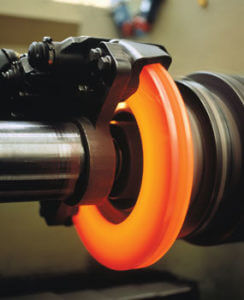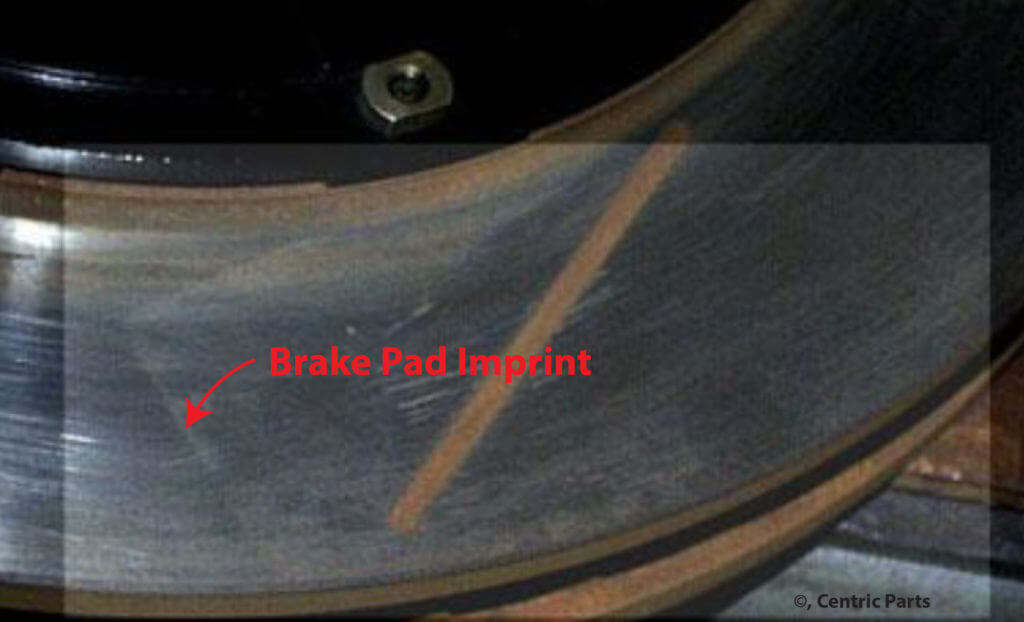Warped brake rotors: There’s no such thing
What causes warped brake rotors?
Let’s do a hard stop right here. Any time the subject of brake pedal pulsation comes up, you’ll hear people say that it’s caused by warped brake rotors.
But brake rotors DO NOT WARP. Yes, you read that correctly. A typical street vehicle can’t possibly generate enough heat to warp a brake rotor. Cast iron doesn’t begin to soften until it reaches close to 1,800°F. There isn’t a street vehicle on this planet that could produce that much brake heat.
Calling it brake rotor warp demonstrates a complete misunderstanding of the metallurgy and the braking process
First: The brake pads and rotors in a street vehicle can’t possibly generate enough heat to warp a brake rotor. As you can see later in this post, the pads would disintegrate long before the rotors reached a high enough temperature to distort.
Second: The heating and cooling that people refer to when discussing “warped brake rotors” would cause cracking, not warping.
Third: High quality brake rotors that pass SAE J2928 Brake Rotor Thermal Cracking Procedure for Vehicles below 4,540 kg GVWR proves they don’t warp
To pass the J2928 rotor test, rotors must withstand at least 150 heat cycles on a dynamometer without cracking or showing any structural or dimensional failure. One heat cycle is defined as a cold rotor that is then braked by brake pads and heated to a high temperature. During the heat  cycle, the rotor will expand and contract but at the end of the test, it must demonstrate dimensional stability with no cracking; in other words, no warping and no cracking.
cycle, the rotor will expand and contract but at the end of the test, it must demonstrate dimensional stability with no cracking; in other words, no warping and no cracking.
A heat cycle can introduce fatigue in a rotor that can cause cracking and structural failure. If the rotor shows any cracking or dimensional instability, it fails the test.
Why heat and cooling don’t cause brake rotor warp
To get cast iron hot enough to soften the metal you’d need to generate almost 2,300°F range. There isn’t a factory stock automotive brake system in the world that’s capable of generating that kind of heat. In fact, you would experience brake pad fade, pad disintegration, brake fluid boiling and rotor discoloration long before you reached 1,000°F.
DEFINITION of Brake Pad Fade: When the temperature of the contact area between the brake pad and the rotor exceeds the thermal capacity of the brake pad friction material, the pad loses its friction capacity due to the outgassing of the binding agents in the material. The pad will still be solid, but it won’t stop the vehicle.
“…brake fade is this thermal degradation of the phenolic resins and other materials in the friction lining, which create a film of gas at the pad-rotor interface and effectively causes the brake pad to skid off the disc. As these gasses build-up at the pad-rotor interface, they produce appreciable backpressure which creates an opposing force to the brake caliper that is trying to hold the pads against the rotor. If there is no way for the gasses to escape, the opposing force as a result of the outgassing can become large enough to prize the pads away from the rotor, reducing the area of pad in contact with the rotor and thus reducing braking power (i.e. brake fade).” — What is Brake Fade? EBC Brakes
Brake pad temperature and disintegration
• OEM and street use aftermarket pads experience fade at 570°F – 662°F
• Racing pads experience fade at 752°F-1,292°F
• At 550°F – 650°F Brake resin odor is present and fade has reduced OEM and street pad braking to almost zero.
• 850°F Brakes begin to smoke
• 1,100°F Brake friction material oxidation occurs at parts of the brake open to air rushing by.
• At 1,200°F friction material begins to carbonize.
Even if you’re traveling straight down the side of a mountain with your brakes applied the entire way. Your brake pads will fade and start to disintegrate long before you come close to heating your rotors enough to soften them to the point where they could warp
In addition, if your brake system is working properly, it’s applying equal pressure to both sides of the rotor which means BOTH SIDES are heating at the same rate. To warp a brake rotor, you must have more heat on one side of the rotor than the other.
Next, see this video from Raybestos
So what causes brake pedal pulsation?
Simple. It’s disc thickness variation (DTV) caused by lateral runout. DTV is either the uneven deposit of brake material onto the face of the rotor OR, the uneven wearing of the rotor face caused by abrasive brake pad material.
The brake pad bedding procedure is critical to ensure proper brake performance after new brake pads are installed. The bedding procedure transfers a uniform film of brake friction material to the face of the rotor. There is no single bedding procedure for all brake pads.
What causes lateral runout?
Corrosion on the wheel hub is the #1 cause of lateral runout
The brake rotor must sit perfectly parallel to the wheel hub. If there’s lateral runout on the hub, either from the factory or due to an impact, the rotor won’t be sitting in a vertical plane with the brake pads. It will wobble and that causes an uneven deposit of friction material on opposite portions of the rotor.
Corrosion on the hub can also cause the rotor to be out of parallel. Cleaning the corrosion off the wheel hub is a CRITICAL step when performing a brake job.
Failure to clean the hub will cause brake pedal pulsation within 3,000 miles. If you replace the rotors with new ones but fail to clean the corrosion, those new rotors will develop brake pedal pulsation again in 3,000 miles.
How much brake pad deposit or wear causes disc thickness variation and brake pedal pulsation?
Not much. Most drivers become aware of brake pedal pulsation with as little as 0.0004″ buildup. When thickness variation reaches 0.001″ the pulsation is so bad that drivers begin to complain.
Improper brake pad bedding is the #2 cause of lateral runout
Racing pad bedding procedure
The bedding procedure for racing pads, for example, requires a gradually increasing sequence of hard slow-downs, finally reaching top speeds of 60-80-MPH and then slowing to around 5-MPH (no complete stops) to heat up the pad sufficiently to transfer friction material film. Once the rotors are fully heated, don’t leave the brakes applied—that will cause friction material transfer in the shape of the pad. This is called pad imprinting (shown below).

The shape of the brake pad friction material deposits onto the face of the rotor when the vehicle is stopped and the brake is left applied after performing a racing pad bedding procedure.
Street brake pad bedding procedure
Again, the procedure varies by brake pad manufacturer and the specific model of brake pads. But generally, street pad bedding usually requires 10 to 30 moderate stops from around 30-MPH to 0-mph with cooling periods in between.
What happens if brake pads aren’t “bedded” properly?
Improper bedding (or no bedding procedure at all) produces uneven friction material deposits on the face of the rotor. During braking, those high spots become hotter than the other portions. When the leading edge of the high spots contacts the brake pad, it generates temperatures in the 1,200 to 1,300°F range. That’s not hot enough to warp the rotor. But it IS hot enough to change the composition of the cast iron. Here’s how that happens:
Cast iron is an alloy of iron, silicon, and carbon that’s heated to form a matrix of carbides. However, at after the initial casting, if temperatures reach around 1,200 to 1,300°F, the matrix changes to form cementite (3 iron atoms and 1 carbon atom).
Cementite is harder than the surrounding cast iron. It is also more abrasive. Worse yet, it doesn’t dissipate heat as easily as the surrounding cast iron, so it creates “hot spots” which grow hotter with every successive brake application, converting more cast iron into cementite.
What about installing new pads on a used rotor?
If the old rotors are within spec (above the discard thickness) and don’t have deep grooves, it can often be reused as long as you perform a bedding procedure with the new brake pads. Ideally, you should use the same friction material as the pads you’re removing. If you don’t know what pads were used, you can try bedding the new pads according to the manufacturer’s instructions. Just be aware that noise is the #1 complaint when installing new pads on used rotors.
How much deposit or wear causes disc thickness variation and brake pedal pulsation?
Not much. Most drivers become aware of brake pedal pulsation with as little as 0.0004″ buildup. When thickness variation reaches 0.001″ the pulsation is so bad that drivers begin to complain.
Improper lug nut torque is the #3 cause of lateral runout
In order to maintain a perfectly parallel fit of the brake rotor to the wheel hub, the clamping force from the lug nuts must be the same on each wheel stud. Never use an impact wrench to tighten lug nuts, even with a torque stick—unless you set your impact on the lowest setting and use the torque stick to seat the lug nuts just enough so you can perform the final tightening by hand with a torque wrench.
If you tighten lug nuts in a circular pattern with an impact wrench, the first few lug nuts will pre-load the rotor, causing it to flex slightly. Then, even if you tighten the remaining lug nuts to the same torque, your torque will be uneven due to the flexed rotor absorbing the energy. You won’t feel brake pedal pulsation when the rotor cold. But as the rotor heats up, it will expand unevenly and cause lateral runout.
That’s why lug nuts must be tightened in a star pattern and by hand with a torque wrench.
Can heavy braking cause warped rotors?
Not really. When a vehicle develops brake pedal pulsation, so-called “experts” say the driver rode the brakes, got them too hot, and the rotors warped like an old vinyl album left in a hot car.
It’s physically impossible for automotive brakes to generate enough heat to cause a cast iron rotor to change its shape. Here’s why:
Brake rotor melting point temperatures
In order for a brake rotor to warp or change shape, it must heat up to near its melting point. Most high-quality auto rotors are made with G3000 or G4000 Gray Cast Iron. Here are the various melting points for cast iron:
G1800 Gray Cast Iron Melt temperature 1150°C 2102°F
G3000 Gray Cast Iron Melt temperature 1145°C 2093°F
G4000 Gray Cast Iron Melt temperature 1145°C 2093°F
1008 Plain Carbon Steel Melt temperature 1620°C 2964°F
During normal street use, brake rotors and pads generate around 200°F to 400°F. When racing or used heavily on a track, they can reach temperatures of up to 1,000°F — still not enough to distort a rotor.
As temperatures rise above 400°F the phenolic resins and other materials in the friction material change from a solid-state into a gas. Gassing produces back pressure, literally pushing the brake pad away from the surface of the rotor. This is what causes a loss of braking called brake fade.
In other words, your street brake pads will fade long before then heat up enough to cause warped rotors. If the shop claims you have warped rotors due to heavy braking, ask them to show you the scorched brake pads. Again, they’ll burn up way before they reach cast iron melting temperatures.
See this post on how to prevent brake pedal pulsation.
©, 2019 Rick Muscoplat
Posted on by Rick Muscoplat